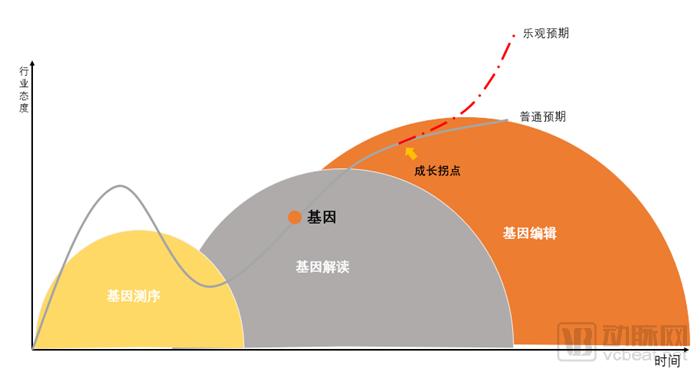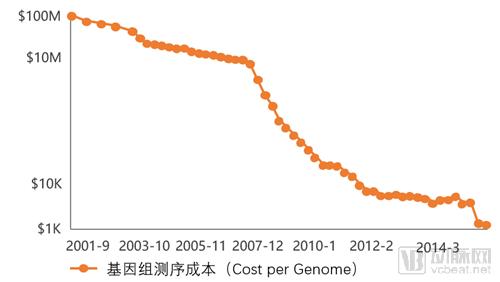Genetic research is an exploration of the origin of life and is another way of looking at the health of life in modern medicine. The mission of the company is to bring prosperity to employees on the basis of achieving social value and bring wealth to the business owners. Gene companies are no exception, and we cannot avoid talking about the issue of gene commercialization. This report explores the commercialization process of the genetic industry by tracking the evolution path of genetic technology, and proposes a relatively complete evaluation system to explore the commercialization value of genes. At the 5th NGS Innovative Developers Conference, the Arterial Network Eggshell Institute gave a speech on the topic of "Investigation of NGS Business Value". This article is a partial excerpt from this report. This report is divided into four parts, including: First, the industrial development path 1.1 From equipment to service, basic research and development bring industry diversification 1.2 National level strategy to continuously improve genetic status Second, the genetic industry pattern 2.1 Industry giants have a full industrial chain layout, and downstream applications are gradually increasing 2.2 domestic sequencer suddenly rises Third, the realization of the business value path 3.1 Industry Commercialization Evaluation System 3.2 Clinical level gene application: technology is king, flowers are blooming 3.2.1 NIPT: Lucky Tickets, Commercialization Mature in 10 Years 3.2.2 Tumor detection and treatment: huge space, policy persistence 3.2.3 Microbial Sequencing: Basic research and regulation are still improving, but the biggest challenge is time 3.3 Consumer-grade genetic applications: experience pain, branded operations Fourth, the value of the outlook 4.1 The genetic industry enters the endogenous growth space, industrial capital enters, and opens the scene value mining 4.2 Where is the extension of cross-border cooperation in genetic technology? First, the development path of the genetic industry 1.1 From equipment to service, basic research and development bring industry diversification According to our understanding of the development path of gene technology, we divide the development of gene technology into three stages, the first stage is gene sequencing , the second stage is gene interpretation, and the third stage is gene editing. Glossary: Gene sequencing: Gene sequencing refers to the determination of the base sequence of DNA molecules by sequencing equipment, ie, the determination and interpretation of adenine (A), thymine (T), cytosine (C) and guanine in DNA molecules ( G) The sequence of four bases to obtain a complete sequence of genes. Gene Interpretation: By comparing the sequence of the sequence with the already integrated database content, to find out the function of the gene and whether there are many sites in the gene sequence specific to the database, so as to judge the relationship between physiological representation and gene locus the process of. Gene editing: A group of techniques that use biotechnology to directly manipulate the genome of an organism and use it to alter the genetic material of a cell. Gene transfer from the same species and across species is included to produce improved or new organisms. The new genetic material can be inserted into the host genome by isolating and replicating the desired genetic material using molecular cloning techniques to produce a DNA sequence, or by synthesizing the DNA and then inserting it into the host organism. Nucleases can be used to remove or "knock out" the gene. Gene targeting is a different technique for using homologous recombination to alter endogenous genes, and can be used to delete genes, remove exons, add genes, or introduce point mutations. The development of the first phase of gene sequencing technology is marked by the implementation of the Human Genome Project, but sequencing flux limitations and high cost have always been the primary obstacles to the in-depth analysis of the genome. The introduction of high-throughput sequencing technology in 2005 initially solved this problem. The cost of sequencing human genomes is rapidly declining. The procurement of a large number of sequencing instruments, the sequencing of a variety of animals and plants cultivated China's sequencing technology talents, and also accelerated China's understanding of the genetic information industry, laying the foundation for China to enter the genetic information interpretation industry. The improvement of sequencing technology has brought about a rapid decline in cost and has greatly promoted commercial development. The second-generation sequencing technology reduced the average cost per megabyte of gene sequencing from $5,292 in 2001 to $0.014 in 2015 (nearly 380000:1). In 2001, the cost of personal genome sequencing was about $100 million. In 2014, HiSeq X Ten, a sequencing platform developed by Illumina, reduced the cost of human genome sequencing to less than $1,000. In January 2017, Illumina released the NovaSeq series of high-throughput sequencing platforms, January 9, 2018. At the P Morgan Health Conference, global genetic testing giant Illumina announced the launch of the NovaSeq series of sequencers with unparalleled throughput, compact operation, low cost and flexibility to reduce gene sequencing costs to $800. The NovaSep series also has a breakthrough in sequencing speed. HiSeqX's genome-wide sequencing time is 72 hours, and the NovaSeq series reduces time to 40 hours. Although there is no real sense of $100 sequencing, Illumina says this goal will be achieved in the next few years. The launch of the NovaSeq system at least marks the arrival of the 100-yuan era of gene sequencing. As technology upgrades again, it is believed that the price of the gene sequencing market will drop to $100, when the genetic testing will have more users and a wider range of applications. Cost of genome sequencing in 2001-2016 The second stage of gene interpretation, simply speaking, is to interpret the human's genetic information, which can be used to describe the physiological functions, disease characteristics, and individualized factors of disease treatment. These descriptions can be used for talent assessment, health care, disease risk assessment, disease diagnosis, medication guidance, and more. Gene interpretation uses gene sequencing results as the basic information input, with the understanding of life activities as the core key technology, and is the basic information guide for health and life. Gene decoding is an upgrade of genetic testing. In contrast, gene decoding is more accurate and advanced in the interpretation and personalization of genetic information. The third stage is gene editing. Gene interpretation can find out the cause of the disease. After the disease gene identification gene is decoded to find the cause, the drug, intervention and health care plan can be designed for targeted treatment, but these methods cannot be eliminated fundamentally. The cause of the disease. Because each cell exists in every cell in the human body, the combination of gene defects in each cell or at least a large number of cells causes disease in the human body. Only by removing the disease-causing gene, it is possible to fundamentally treat diseases caused by genetic defects. Moreover, many serious diseases are caused by changes in a single gene and a single locus. Genetic decoding can accurately determine the existence of defective genes, thereby making genetic correction possible. The maturity of basic gene sequencing technology and the rapid decline of cost, genetic interpretation and gene editing technology are beginning to make the genetic industry show diversified characteristics. We expect that when gene interpretation technology develops to the lower half, gene editing technology goes to the first half. The genetic industry will usher in an inflection point and embark on an industry optimistic curve. Tetanus Toxoid Vaccine,Toxoid Vaccine,Hep B Immune Globulin,Immunoglobulin Injections FOSHAN PHARMA CO., LTD. , https://www.foshanpharma.com
